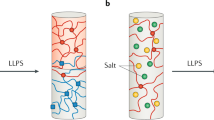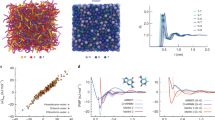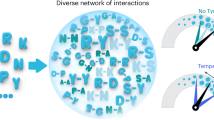Abstract
Various physics- and data-driven sequence-dependent protein coarse-grained models have been developed to study biomolecular phase separation and elucidate the dominant physicochemical driving forces. Here we present Mpipi, a multiscale coarse-grained model that describes almost quantitatively the change in protein critical temperatures as a function of amino acid sequence. The model is parameterized from both atomistic simulations and bioinformatics data and accounts for the dominant role of π–π and hybrid cation–π/π–π interactions and the much stronger attractive contacts established by arginines than lysines. We provide a comprehensive set of benchmarks for Mpipi and seven other residue-level coarse-grained models against experimental radii of gyration and quantitative in vitro phase diagrams, demonstrating that Mpipi predictions agree well with experiments on both fronts. Moreover, Mpipi can account for protein–RNA interactions, correctly predicts the multiphase behavior of a charge-matched poly-arginine/poly-lysine/RNA system, and recapitulates experimental liquid–liquid phase separation trends for sequence mutations on FUS, DDX4 and LAF-1 proteins.
This is a preview of subscription content, access via your institution
Access options
Access Nature and 54 other Nature Portfolio journals
Get Nature+, our best-value online-access subscription
$29.99 / 30 days
cancel any time
Subscribe to this journal
Receive 12 digital issues and online access to articles
$99.00 per year
only $8.25 per issue
Buy this article
- Purchase on Springer Link
- Instant access to full article PDF
Prices may be subject to local taxes which are calculated during checkout






Similar content being viewed by others
Data availability
All relevant supporting data are available in the figshare data repository at https://doi.org/10.6084/m9.figshare.1677281270. The data for this study were generated with the simulation codes and algorithms outlined in Supplementary Table 14, using the supporting code70, alongside standard command-line tools. Source data are provided with this paper.
Code availability
LAMMPS input scripts and parameter files are available in the figshare data repository at https://doi.org/10.6084/m9.figshare.1677281270.
References
Hyman, A. A. & Simons, K. Beyond oil and water-phase transitions in cells. Science 337, 1047–1049 (2012).
Li, P. et al. Phase transitions in the assembly of multivalent signalling proteins. Nature 483, 336–340 (2012).
Alberti, S. & Dormann, D. Liquid-liquid phase separation in disease. Annu. Rev. Genet. 53, 171–194 (2019).
Martin, E. W. et al. Valence and patterning of aromatic residues determine the phase behavior of prion-like domains. Science 367, 694–699 (2020).
Choi, J.-M., Holehouse, A. S. & Pappu, R. V. Physical principles underlying the complex biology of intracellular phase transitions. Annu. Rev. Biophys. 49, 107–133 (2020).
Fisher, R. S. & Elbaum-Garfinkle, S. Tunable multiphase dynamics of arginine and lysine liquid condensates. Nat. Commun. 11, 4628 (2020).
Krainer, G. et al. Reentrant liquid condensate phase of proteins is stabilized by hydrophobic and non-ionic interactions. Nat. Commun. 12, 1085 (2021).
Harmon, T. S., Holehouse, A. S., Rosen, M. K. & Pappu, R. V. Intrinsically disordered linkers determine the interplay between phase separation and gelation in multivalent proteins. eLife 6, e30294 (2017).
Choi, J. M., Dar, F. & Pappu, R. V. LASSI: a lattice model for simulating phase transitions of multivalent proteins. PLoS Comput. Biol. 15, e1007028 (2019).
Bremer, A. et al. Deciphering how naturally occurring sequence features impact the phase behaviors of disordered prion-like domains. Preprint at bioRxiv https://doi.org/10.1101/2021.01.01.425046 (2021).
Wang, J. et al. A molecular grammar governing the driving forces for phase separation of prion-like RNA binding proteins. Cell 174, 688–699 (2018).
Qamar, S. et al. FUS phase separation is modulated by a molecular chaperone and methylation of arginine cation-π interactions. Cell 173, 720–734 (2018).
Vernon, R. M. et al. π-π contacts are an overlooked protein feature relevant to phase separation. eLife 7, e31486 (2018).
Brady, J. P. et al. Structural and hydrodynamic properties of an intrinsically disordered region of a germ cell-specific protein on phase separation. Proc. Natl Acad. Sci. USA 114, E8194–E8203 (2017).
Dubreuil, B., Matalon, O. & Levy, E. D. Protein abundance biases the amino acid composition of disordered regions to minimize non-functional interactions. J. Mol. Biol. 431, 4978–4992 (2019).
Fossat, M. J., Zeng, X. & Pappu, R. V. Uncovering differences in hydration free energies and structures for model compound mimics of charged side chains of amino acids. J. Phys. Chem. B 125, 4148–4161 (2021).
Dyson, H. J., Wright, P. E. & Scheraga, H. A. The role of hydrophobic interactions in initiation and propagation of protein folding. Proc. Natl Acad. Sci. USA 103, 13057–13061 (2006).
Andrew, C. D. et al. Stabilizing interactions between aromatic and basic side chains in α-helical peptides and proteins. Tyrosine effects on helix circular dichroism. J. Am. Chem. Soc. 124, 12706–12714 (2002).
Noid, W. G. Perspective: coarse-grained models for biomolecular systems. J. Chem. Phys. 139, 090901 (2013).
Hills, R. D., Lu, L. & Voth, G. A. Multiscale coarse-graining of the protein energy landscape. PLoS Comput. Biol. 6, e1000827 (2010).
Ruff, K. M., Harmon, T. S. & Pappu, R. V. CAMELOT: a machine learning approach for coarse-grained simulations of aggregation of block-copolymeric protein sequences. J. Chem. Phys. 143, 243123 (2015).
Zeng, X., Holehouse, A. S., Chilkoti, A., Mittag, T. & Pappu, R. V. Connecting coil-to-globule transitions to full phase diagrams for intrinsically disordered proteins. Biophys. J. 119, 402–418 (2020).
Latham, A. P. & Zhang, B. Consistent force field captures homologue-resolved HP1 phase separation. J. Chem. Theory Comput. 17, 3134–3144 (2021).
Dannenhoffer-Lafage, T. & Best, R. B. A data-driven hydrophobicity scale for predicting liquid-liquid phase separation of proteins. J. Phys. Chem. B 125, 4046–4056 (2021).
Tesei, G., Schulze, T. K., Crehuet, R. & Lindorff-Larsen, K. Accurate model of liquid–liquid phase behavior of intrinsically disordered proteins from optimization of single-chain properties. Proc. Natl Acad. Sci. USA 118, e2111696118 (2021).
Dignon, G. L., Zheng, W. W., Kim, Y. C., Best, R. B. & Mittal, J. Sequence determinants of protein phase behavior from a coarse-grained model. PLoS Comput. Biol. 14, e1005941 (2018).
Regy, R. M., Thompson, J., Kim, Y. C. & Mittal, J. Improved coarse-grained model for studying sequence dependent phase separation of disordered proteins. Protein Sci. 30, 1371–1379 (2021).
Souza, P. C. T. et al. Martini 3: a general purpose force field for coarse-grained molecular dynamics. Nat. Methods 18, 382–388 (2021).
Benayad, Z., von Bülow, S., Stelzl, L. S. & Hummer, G. Simulation of FUS protein condensates with an adapted coarse-grained model. J. Chem. Theory Comput. 17, 525–537 (2021).
Reith, D., Pütz, M. & Müller-Plathe, F. Deriving effective mesoscale potentials from atomistic simulations. J. Comput. Chem. 24, 1624–1636 (2003).
van Hoof, B., Markvoort, A. J., van Santen, R. A. & Hilbers, P. A. A novel method for coarse graining of atomistic simulations using Boltzmann inversion. Biophys. J. 100, 309a (2011).
Ercolessi, F. & Adams, J. B. Interatomic potentials from first-principles calculations: the force-matching method. Europhys. Lett. 26, 583–588 (1994).
Lu, L., Dama, J. F. & Voth, G. A. Fitting coarse-grained distribution functions through an iterative force-matching method. J. Chem. Phys. 139, 121906 (2013).
Izvekov, S. & Voth, G. A. A multiscale coarse-graining method for biomolecular systems. J. Phys. Chem. B 109, 2469–2473 (2005).
Johnson, M. E., Head-Gordon, T. & Louis, A. A. Representability problems for coarse-grained water potentials. J. Chem. Phys. 126, 144509 (2007).
Reinhardt, A. & Cheng, B. Quantum-mechanical exploration of the phase diagram of water. Nat. Commun. 12, 588 (2021).
Wang, J. et al. Machine learning of coarse-grained molecular dynamics force fields. ACS Cent. Sci. 5, 755–767 (2019).
Opitz, A. Molecular dynamics investigation of a free surface of liquid argon. Phys. Lett. A 47, 439–440 (1974).
Wang, X., Ramírez-Hinestrosa, S., Dobnikar, J. & Frenkel, D. The Lennard-Jones potential: when (not) to use it. Phys. Chem. Chem. Phys. 22, 10624–10633 (2020).
Das, S., Lin, Y.-H., Vernon, R. M., Forman-Kay, J. D. & Chan, H. S. Comparative roles of charge, π, and hydrophobic interactions in sequence-dependent phase separation of intrinsically disordered proteins. Proc. Natl Acad. Sci. USA 117, 28795–28805 (2020).
Kim, Y. C. & Hummer, G. Coarse-grained models for simulations of multiprotein complexes: application to ubiquitin binding. J. Mol. Biol. 375, 1416–1433 (2008).
Kapcha, L. H. & Rossky, P. J. A simple atomic-level hydrophobicity scale reveals protein interfacial structure. J. Mol. Biol. 426, 484–498 (2014).
Li, H., Tang, C. & Wingreen, N. S. Nature of driving force for protein folding: a result from analyzing the statistical potential. Phys. Rev. Lett. 79, 765–768 (1997).
Urry, D. W. et al. Hydrophobicity scale for proteins based on inverse temperature transitions. Biopolymers 32, 1243–1250 (1992).
Tejedor, A. R., Garaizar, A., Ramírez, J. & Espinosa, J. R. Dual RNA modulation of protein mobility and stability within phase-separated condensates. Preprint at bioRxiv https://doi.org/10.1101/2021.03.05.434111 (2021).
Lin, Y.-H. & Chan, H. S. Phase separation and single-chain compactness of charged disordered proteins are strongly correlated. Biophys. J. 112, 2043–2046 (2017).
Riback, J. A. et al. Stress-triggered phase separation is an adaptive, evolutionarily tuned response. Cell 168, 1028–1040 (2017).
Dignon, G. L., Zheng, W., Best, R. B., Kim, Y. C. & Mittal, J. Relation between single-molecule properties and phase behavior of intrinsically disordered proteins. Proc. Natl Acad. Sci. USA 115, 9929–9934 (2018).
Fare, C. M., Villani, A., Drake, L. E. & Shorter, J. Higher-order organization of biomolecular condensates. Open Biol. 11, 210137 (2021).
Regy, R. M., Dignon, G. L., Zheng, W., Kim, Y. C. & Mittal, J. Sequence dependent phase separation of protein-polynucleotide mixtures elucidated using molecular simulations. Nucleic Acids Res. 48, 12593–12603 (2020).
Choi, J.-M., Hyman, A. A. & Pappu, R. V. Generalized models for bond percolation transitions of associative polymers. Phys. Rev. E 102, 042403 (2020).
Zeng, X. et al. Design of intrinsically disordered proteins that undergo phase transitions with lower critical solution temperatures. APL Mater. 9, 021119 (2021).
Banerjee, P. R., Milin, A. N., Moosa, M. M., Onuchic, P. L. & Deniz, A. A. Reentrant phase transition drives dynamic substructure formation in ribonucleoprotein droplets. Angew. Chem. Int. Ed. 56, 11354–11359 (2017).
Alshareedah, I. et al. Interplay between short-range attraction and long-range repulsion controls reentrant liquid condensation of ribonucleoprotein-RNA complexes. J. Am. Chem. Soc. 141, 14593–14602 (2019).
Dignon, G. L., Zheng, W., Kim, Y. C. & Mittal, J. Temperature-controlled liquid-liquid phase separation of disordered proteins. ACS Cent. Sci. 5, 821–830 (2019).
Best, R. B., Zheng, W. & Mittal, J. Balanced protein-water interactions improve properties of disordered proteins and non-specific protein association. J. Chem. Theory Comput. 10, 5113–5124 (2014).
Benavides, A. L., Aragones, J. L. & Vega, C. Consensus on the solubility of NaCl in water from computer simulations using the chemical potential route. J. Chem. Phys. 144, 124504 (2016).
Liu, H., Fu, H., Shao, X., Cai, W. & Chipot, C. Accurate description of cation-π interactions in proteins with a nonpolarizable force field at no additional cost. J. Chem. Theory Comput. 16, 6397–6407 (2020).
Paloni, M., Bailly, R., Ciandrini, L. & Barducci, A. Unraveling molecular interactions in liquid-liquid phase separation of disordered proteins by atomistic simulations. J. Phys. Chem. B 124, 9009–9016 (2020).
Wessén, J., Pal, T., Das, S., Lin, Y.-H. & Chan, H. S. A simple explicit-solvent model of polyampholyte phase behaviors and its ramifications for dielectric effects in biomolecular condensates. J. Phys. Chem. B 125, 4337–4358 (2021).
Holcomb, C. D., Clancy, P. & Zollweg, J. A. A critical study of the simulation of the liquid-vapour interface of a Lennard-Jones fluid. Mol. Phys. 78, 437–459 (1993).
Reinhardt, A. Phase behavior of empirical potentials of titanium dioxide. J. Chem. Phys. 151, 064505 (2019).
Gallivan, J. P. & Dougherty, D. A. Cation-π interactions in structural biology. Proc. Natl Acad. Sci. USA 96, 9459–9464 (1999).
Song, J., Ng, S. C., Tompa, P., Lee, K. A. W. & Chan, H. S. Polycation-π interactions are a driving force for molecular recognition by an intrinsically disordered oncoprotein family. PLoS Comput. Biol. 9, e1003239 (2013).
Auton, M. & Bolen, D. W. Application of the transfer model to understand how naturally occurring osmolytes affect protein stability. Methods Enzymol. 428, 397–418 (2007).
Kumar, K. et al. Cation-π interactions in protein-ligand binding: theory and data-mining reveal different roles for lysine and arginine. Chem. Sci. 9, 2655–2665 (2018).
Chapela, G. A., Saville, G., Thompson, S. M. & Rowlinson, J. S. Computer simulation of a gas-liquid surface. Part 1. J. Chem. Soc. Faraday Trans. 2 73, 1133–1144 (1977).
Nilsson, D. & Irbäck, A. Finite-size scaling analysis of protein droplet formation. Phys. Rev. E 101, 022413 (2020).
Vitalis, A. & Pappu, R. V. ABSINTH: a new continuum solvation model for simulations of polypeptides in aqueous solutions. J. Comput. Chem. 30, 673–699 (2009).
Joseph, J. A. et al. Code and data for ‘Physics-driven coarse-grained model for biomolecular phase separation with near-quantitative accuracy’. figshare https://doi.org/10.6084/m9.figshare.16772812 (2021).
Acknowledgements
We thank D. Frenkel for useful comments on the manuscript, J. Mittal and G. L. Dignon for helping us implement the HPS-KR potential in LAMMPS and G. Tesei and K. Lindorff-Larsen for helping us debug our implementation of their potential. This project has received funding from the European Research Council under the European Union’s Horizon 2020 research and innovation programme (grant no. 803326; R.C.-G.). J.A.J. is a Junior Research Fellow at King’s College. R.C.-G. is an Advanced Fellow of the Winton Programme for the Physics of Sustainability. J.R.E. acknowledges funding from the Oppenheimer Fellowship of the University of Cambridge and the Roger Ekins Fellowship from Emmanuel College. A.G. is funded by the EPSRC (Doctoral Training Partnership, grant no. EP/N509620/1) and the Winton Programme for the Physics of Sustainability. P.Y.C. is funded by the University of Cambridge Ernest Oppenheimer Fund and the Winton Programme for the Physics of Sustainability. K.O.R. is funded by the EPSRC (Doctoral Training Partnership, grant no. EP/T517847/1). This work was performed using resources provided by the Cambridge Tier-2 system operated by the University of Cambridge Research Computing Service funded by EPSRC Tier-2 capital grant no. EP/P020259/1 (R.C.-G., J.A.J. and A.R.). The funders had no role in study design, data collection and analysis, decision to publish or preparation of the manuscript.
Author information
Authors and Affiliations
Contributions
J.A.J. and R.C.-G. conceived the project. J.A.J., A.R. and R.C.-G. designed the model and benchmarking framework. J.A.J. and A.R. implemented and optimized the model. J.A.J., A.R., A.A., P.Y.C., K.O.R., J.R.E. and A.G. validated the model and analyzed the data. J.A.J. and A.R. wrote the manuscript with help from R.C.-G. All authors reviewed the manuscript. J.A.J., A.R. and R.C.-G. acquired funding. J.A.J., A.R. and R.C.-G. supervised the research.
Corresponding authors
Ethics declarations
Competing interests
The authors declare no competing interests.
Additional information
Peer review information Nature Computational Science thanks Hue Sun Chan and the other, anonymous, reviewer(s) for their contribution to the peer review of this work. Peer reviewer reports are available. Handling editor: Jie Pan, in collaboration with the Nature Computational Science team.
Publisher’s note Springer Nature remains neutral with regard to jurisdictional claims in published maps and institutional affiliations.
Supplementary information
Supplementary Information
Supplementary Discussion, including amino acid listings, Figs. 1–10 and Tables 1–13.
Source data
Source Data Fig. 2
Source data for Fig. 2, panels a–e. Zipped plain text.
Source Data Fig. 3
Source data for Fig. 3, panels a–f. Zipped plain text.
Source Data Fig. 4
Source data for Fig. 4, panels a–g. Zipped plain text.
Source Data Fig. 5
Source data for Fig. 5, panels a–m. Zipped plain text.
Source Data Fig. 6
Source data for Fig. 6, panels a–d. Zipped plain text.
Rights and permissions
About this article
Cite this article
Joseph, J.A., Reinhardt, A., Aguirre, A. et al. Physics-driven coarse-grained model for biomolecular phase separation with near-quantitative accuracy. Nat Comput Sci 1, 732–743 (2021). https://doi.org/10.1038/s43588-021-00155-3
Received:
Accepted:
Published:
Issue Date:
DOI: https://doi.org/10.1038/s43588-021-00155-3
This article is cited by
-
Direct prediction of intrinsically disordered protein conformational properties from sequence
Nature Methods (2024)
-
An easy-to-use computational tool for predicting 3D properties of disordered proteins
Nature Methods (2024)
-
The molecular basis for cellular function of intrinsically disordered protein regions
Nature Reviews Molecular Cell Biology (2024)
-
Predictive scale-bridging simulations through active learning
Scientific Reports (2023)
-
Atomistic modeling of liquid-liquid phase equilibrium explains dependence of critical temperature on γ-crystallin sequence
Communications Biology (2023)



